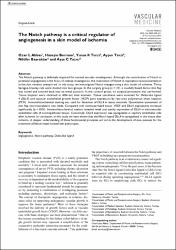The Notch pathway is a critical regulator of angiogenesis in a skin model of ischemia

View/
Access
info:eu-repo/semantics/closedAccessDate
2015Author
Abbas, Ozan L.Borman, Huseyin
Terzi, Yunus K.
Terzi, Aysen
Bayraktar, Nilufer
Yazici, Ayse C.
Metadata
Show full item recordAbstract
The Notch pathway is definitely required for normal vascular development. Although the contribution of Notch in postnatal angiogenesis is the focus of intense investigation, the implication of Notch in reparative neovascularization in the skin remains unexplored. In this study, we investigated Notch changes using a skin model of ischemia. Thirty Sprague-Dawley rats were divided into two groups. In the surgery group (n = 24), a caudally based dorsal skin flap was raised and sutured back into its initial position. In the control group, no surgical procedure was performed. Tissue biopsies were obtained at different time intervals. Tissue specimens were assessed for Delta-like ligand 4 (DLL4) and vascular endothelial growth factor (VEGF) gene expression by real-time polymerase chain reaction (PCR). Immunohistochemical staining was used for detection of DLL4 in tissue materials. Quantitative assessment of skin flap microvasculature was made. Compared with normoperfused tissue, VEGF and DLL4 expressions increased significantly (p < 0.01). Immunohistochemical analysis revealed weak and patchy expression of DLL4 in microvascular endothelial cells of normoperfused tissues. Conversely, DLL4 expression was upregulated in capillary endothelial cells after ischemia. In conclusion, in this study we have shown that the Notch ligand DLL4 is upregulated in skin tissue after ischemia. A deeper understanding of these fundamental principles will aid in the development of new avenues for the treatment of blood vessel-related skin pathologies.

















